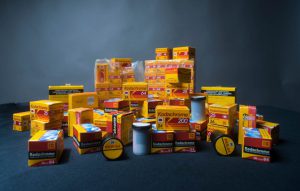
This week’s featured article is an excellent piece on EMULSIVE by Kelly-Shane Fuller who if you’ve been following film photography sites, you know as the guy trying to reverse engineer Kodachrome.
For those who wonder what the big deal is, Kodachrome was a very popular and very complicated color slide film that was made from the 1930s until 2010 when Kodak stopped making development chemicals for it.
Unlike other film emulsions, Kodachrome is actually a black and white film that has multiple color sensitive layers embedded within, and the colors you see in developed images are “inserted” during the development process by a series of very environmentally nasty chemicals. Reverse engineering Kodachrome requires figuring out each step which is a monumental task for a hobbyist to attempt, but Kelly-Shane has been working on this for a couple of years.
His results, even today, do not match that of Kodachrome developed using the correct stuff, but the fact that he’s even gotten this close is impressive! If you are a fan of strange color shifts, distinct imagery, or just need to get some kind of image from some old undeveloped Kodachrome, this is the article for you!
Here are more great posts from some of my favorite sites:
The Nikon F100 was the successor to the excellent N90s and is a camera I’ve tried to get, but used F100s seem to fall into one of two categories. Expensive, and with broken or missing film doors. It would seem that for as great of a camera as this is, finding them in good working condition requires a big investment, but thankfully Stephen Dowling from Kosmo Foto is here to give you his take on the F100. This is a camera he says he’s shot over 500 rolls of film in over a 15 year span, so this is perhaps the longest review in the making of any I’ve ever seen. I don’t know whether I should thank Stephen for such a great review or curse him for making me want one even more!
Many people consider the Leica M3 to be one of the holy grails of cameras, and for good reason. It’s freaking awesome! When I reviewed one back in January 2017, it was a loaner and I’ve missed that camera ever since I gave it back. This week Theo from photothinking.com gives us his review on an early Double Stroke model. Theo’s review is really well written, but let’s be honest, you’re going to love the images he got from his. Theo is clearly a better photographer than I and if the saying “a picture is worth a thousand words” this is a REALLY long article!
Most everyone who would come to this site is familiar with the Nikon F2 and Nikkormat FT, but what about the lesser well known variants of those two cameras, the F2AS and Nikkormat FT3? This week Bill Smith from his website of the same name gives us a 1-2 punch of two of these wonderfully overlooked Nikon SLRs. First is the Nikon F2AS which has a unique exposure meter capable of infinitely variable manual shutter speeds, and uses LEDs in the viewfinder instead of analog needles like all over Nikon meters of the time. Second is the FT3, the last in the original Nikkormat lineup and the very first Nikon camera to support AIs lenses (it came even a year before my beloved EL2). If you like Nikon SLRs, but are bored of reviews of the same models, check out Bill’s site!
There aren’t a ton of options for fast black and white films at 1600 and higher, so sometimes photographers have to get creative and push slower films to faster speeds. If you were to ask 100 film photographers which film is ideal to push to 1600, I don’t think many would say Kentmere 400, but that’s what Alan Duncan from Canny Cameras did, and his results are impressive! There is some grain as you might expect from any 1600 film, but the overall look of the images he got are outstanding! I don’t own any Kentmere 400, but that won’t be true for long!
People often ask in vintage camera forums what is the “best” lens or “best” camera, when in reality what they should be asking is, what is the “right” camera or lens, and that’s what Alyssa from Aly’s Vintage Camera Alley did when she selected the Mamiya 645 Pro. Alyssa walks you through her thought process and criteria along with some thoughts on the camera and some sample images. For anyone whose heard me promote Alyssa’s posts before, you should already know I think she’s a fantastic writer, but also supplements her written articles with an excellent Youtube video as well! Be sure to check it out!
It’s not exactly camera-centric, but my favorite Hoosier, Jim Grey, writes about one of my all time favorite places in the whole world, Bridgeton, Indiana. For those unaware, Bridgeton is a small town in Parke County, Indiana that is home to 31 covered bridges, most of which are still in active use today. If you like covered bridges or just old things in general, this area of the country is well worth visiting. And if that’s not enough for you, nearby Turkey Run State Park has some of the best hiking trails of anywhere in the Midwest of the United States.
Continuing his series of favorite lenses by photo geeks from 2 weeks ago, Casual Photophile brings us an entire favorite lens article written by one of my favorite contributors, Cheyenne Morrison. Cheyenne is not only a camera and lens enthusiast and is into history of things like I am, but his articles are always very well researched and fascinating to read. Cheyenne’s favorite lens is the strange looking but ordinary sounding Schneider Kreuznach Super Xenar 50mm F/2.8 in M42 mount. A f/2.8 50mm lens may not sound that interesting on paper, so I strongly recommend you check out Cheyenne’s article!
Peggy Marsh from Camera Go Camera (just don’t ever visit Go Camera Go) gives us her thoughts on the Kodak Retinette IB Type 045. For those unfamiliar, the Retinette series was an economy version of the Retina series, featuring less expensive lenses and usually lacking in a few features. But this “lesser Retina” is still better than most cameras of the day. Peggy’s results really help reinforce how good Kodak AG was at making cameras in those days. Her declaration of how easy it was to focus the Retinette reinforces my frequent comments that scale focus cameras are often easier and faster to use than rangefinders.
It’s bad enough Kosmo Foto has upped my desire to own an F100, but now there’s the panoramic KMZ FT-2 that was reviewed by Žiga Četrtič (definitely had to copy and paste that one). If you didn’t know any better, this little rectangular box doesn’t even look like much of a camera, but once you take a closer look, this is a neat little 35mm swing lens panoramic camera that shoots massive 24x110mm images on regular 35mm film like this:
 Eat that Hasselblad Xpan! My wallet is definitely going to hurt after this one.
Eat that Hasselblad Xpan! My wallet is definitely going to hurt after this one.
Finally! A camera review that isn’t going to compel me to go out and buy one of my own as I already have one. Last week my friend and unapologetic Nikon fan Alex Luyckx looks at Nikon’s “camera for women” the Nikon EM. This is a camera often dismissed by Nikon collectors as it has very little manual control and is essentially a “point and shoot SLR”. But being what it is, the Nikon EM is still compatible with Nikon F-mount lenses, has an excellent viewfinder, excellent metering, and can still shoot it’s shutter at 1/90 with a dead battery. The best part about these cameras is that they can still be found today cheap as hell! If you have any Nikon F-mount lenses and want a compact and easy to use SLR, you could do a lot worse than the EM!
I’ve never been a big fan of Kodak Gold 200 as the colors never seem to be that vibrant and it also lacks the distinctness of Portra 160. When I first discovered Kodak ColorPlus 200 I was excited to see if it was a better comparison to Fuji 200 and it was! So now that I’m a recent Kodak ColorPlus fan, I see this article today from Teemu Matilainen from EMULSIVE who developed it in black and white, and the results are quite impressive. Teemu used ID-11 to develop it and used the same steps he would use for Tri-X and the images he got had the type of low contrast and grain that I like! I’m not sure this is anything I’d do myself, but it’s a neat project to look at!
One last note for this week is that a large number of these posts in my Recommended Reading series come from my Camera Bloggers Alliance RSS page which has the 5 most recent posts from 15 of my favorite blogs, and I am excited to see that other bloggers are starting to do the same thing.
Peggy Marsh on Camera Go Camera has her own RSS feed page that works much like my own, but has some of her favorite sites too!
Oh man! 2020 has been a dumpster fire in many ways, but when it comes to new music from some of my favorite bands, we’re already off to a great start, but none more than the new release “Obsidian” by the UK’s Paradise Lost. This is a band I’ve been a huge fan of since I first heard 1996’s “Draconian Times” and although their output has varied in quality in the years since, this new album is absolutely fantastic.
I wish there was a way I could force people I know to like the same music as I, but I get it, music preference is a personal choice, but with that in mind, this is one of the best songs I’ve heard in a long time, by any band and even if it’s not your favorite style of music, I hope some of you will at least give it a chance.



An interesting, varied photographic “reading list.”
I see that “bathroom photochemistry” is as live and well as it was during the days of “Mannes & Godowski,” who developed Kodachrome.
Pushing Kentmere 400 to E.I. 1600 takes me back to my Diafine days of “available darkness.”
A “Schneider Super Xenar”? Now that is an interesting lens from the early days of 35mm SLR cameras of the 1950’s.
KMZ’s FT-2 does make the “6X18” 120 roll film camera format look “quite narrow” by comparison.
I’ll have to take a closer look at the other articles “as time goes by.” (It’s laundry day, for me.;)
I am glad you enjoy my recommendations. I start with bloggers that I know have good content and I look for things that are unique or interesting to me, so if I like them, there’s at least a chance you will too!
Wow, Mike! That’s a packed reading list, and I have read a few posts on that list before your website.
But I’m here to jump to the emulsive article on Kodachrome.
I am glad you find the links useful and have already read a few of them suggesting we have similar tastes in what we both consider to be interesting!